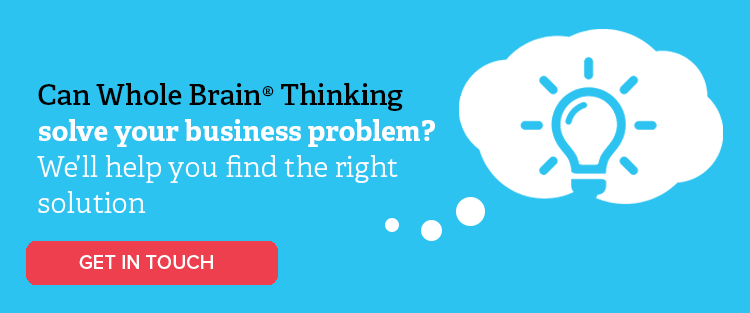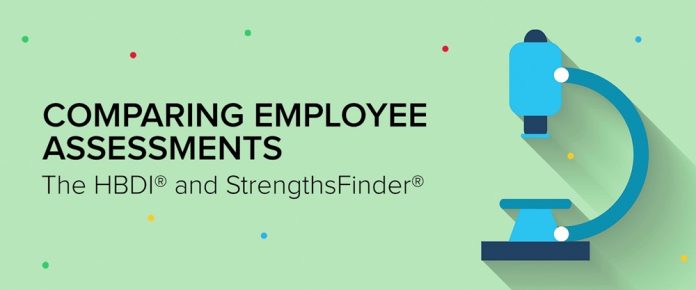In this ongoing blog series, we take a look at the similarities and differences of many employee assessment instruments and how you might use them – individually and together – to achieve your business and talent development needs. For this post, we look at StrengthsFinder® and how it compares with Whole Brain® Thinking and the HBDI®.
As the name implies, the Clifton StrengthsFinder® assessment is a talent assessment with a premise rooted in identifying strengths. It’s based on Gallup research that shows that people succeed when they focus on what they do best.
What we like about the StrengthsFinder® approach is its positive focus. For many, development has always been about finding the problem and fixing what’s broken. This is a mindshift. Instead of emphasising your weaknesses, it’s about amplifying your strengths, maximising your talents and growing the areas where you have the greatest potential to succeed.
That repositioning is very appealing, especially for those of us who have traditionally been told we need to spend all this time on the things we don’t like to do! And the argument follows that the more time you spend applying your talents, the more engaged and fulfilled you’ll be at work and in life.
StrengthsFinder® is primarily used in talent management conversations, career counselling, coaching and individual development. For practitioners, there are a variety of supporting tools you can use to encourage people to build on their strengths, including a book, coaching kits and different levels of the assessment, from identifying your top five strengths to the full 34 strengths. And although there’s no specific “team report”, some leaders will create their own spreadsheets to help their team recognise the breadth of talent and strengths on the team.
Similarities and Differences Between StrengthsFinder® and the HBDI®
We often see parallels between someone’s strengths on the StrengthsFinder® assessment and their thinking preferences as revealed in their HBDI® Profile. This makes sense, since people tend to spend time building up talent in the areas they prefer to operate in.
While thinking preferences aren’t the same as competencies, if you prefer, say, analytical, fact-based thinking, you’re naturally going to gravitate toward activities and careers that emphasise that mode of thinking, and you’ll reinforce those thinking strengths and related talents.
Of course, there can be a downside to focusing only on your strengths. Some individuals, particularly those looking to move up in an organisation, will need development in their “blind spot” areas. StrengthsFinder® will be limited in how far it can take them in that process.
Additionally, because StrengthsFinder® is a tool for self-awareness, it’s mostly focused on the individual, not on understanding others or building awareness and skill in collaborating with those around you. This can limit its broader business value.
Likewise, there’s no methodology or model to easily move from awareness to insight to practical workplace application. By contrast, after taking the HBDI®, you not only get awareness and insight about your own thinking, how it relates to others and the way you get things done, you also have the Whole Brain® Model and tools to use in practice. You could use the Whole Brain® Model to help you create a strategic plan for the company; that kind of scalability isn’t available with StrengthsFinder®.
In this sense, StrengthsFinder® is more of a niche product, but it works well as a complementary tool to use in conjunction with the HBDI®. Like the HBDI®, it has a positive message, and strengths often overlap with thinking preferences, making it easy to see how the two build off each other. The HBDI® can confirm and add depth and breadth to the conversation, helping people find ways to use their strengths in service of some of those “blind spot” areas that need development.
Here are a few points to consider when using both:
- Although thinking preferences and strengths are often connected, note that the HBDI®, which has a brain-based premise, measures something different than the StrengthsFinder® assessment.
- Be careful about how the language and labels of the strengths are defined and interpreted. What do we mean by “learner,” for example? We know from our research that different thinkers can attach different meanings to the same words, so it’s important to be clear about terminology.
- When working with individuals, encourage them to look at the patterns of similarities between the two profiles and how this might inform their development and career decisions. For those who want or need to stretch, the HBDI® is helpful in showing them that, while they aren’t limited to their preferences, it will take dedicated energy and effort, so they need to mentally prepare for it.
- While you can manually assemble a “team profile” of strengths, for more in-depth discussion and application, use the HBDI® Team Profile. It will give you a comprehensive look at the team’s preferences and blind spots, along with tools to align the team behind a common vision and optimise their interactions and performance.
If you’d like to find out more about how HBDI can help you solve any business problem, get in touch with Herrmann.

This article was originally published in 2019. It has been updated in 2020 and republished to ensure our readers don’t miss out on valuable information.

